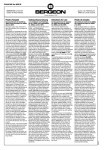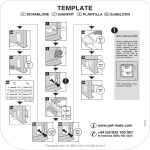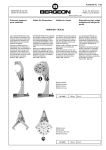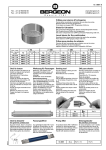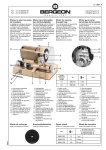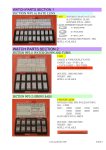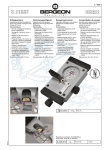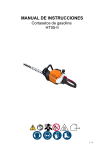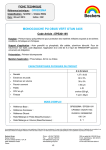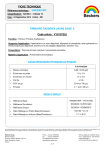Download Assortiment de réactifs Sortiment von Probier
Transcript
PLANCHE No 9045 A BERGEON & Cie SA Outils et fournitures 11, Av. du Technicum 2400 Le Locle Suisse Maison fondée en 1791 Assortiment de réactifs Sortiment von Probiersäuren Assortment of reagents Surtido de reactivos Pour essais: - d’or - de platine - d’argent Contenu: 1 flacon pour or 7-10 ct. 1 ” ” ” 12 ct. 1 ” ” ” 14 ct. 1 ” ” ” 18 ct. pour or gris, platine et argent. 1 pierre de touche 1 mode d’emploi. Zu erproben: - Gold - Platin - Silber Inhalt: 1 Fläschen für Gold von 7-10 Kt. 1 ” ” ” ” 12 Kt. 1 ” ” ” ” 14 Kt. 1 ” ” ” ” 18 Kt. für Weissgold, Platin und Silber 1 Probierstein 1 Gebrauchsanweisung. For testing: - gold - platinum - silver Contents: 1 bottle for gold 7-10 ct. 1 ” ” ” 12 ct. 1 ” ” ” 14 ct. 1 ” ” ” 18 ct. for white gold, platinum and silver 1 touchstone 1 instructions for use. Para pruebas de: - oro - platino - plata Contenido: 1 frasco para oro 7-10 qt. 1 ” ” ” 12 qt. 1 ” ” ” 14 qt. 1 ” ” ” 18 qt. por oro gris, platino y plata. 1 piedra de toque 1 modo de empleo. No 30502 Ampoules Ampullen 1.050 Kg. Pce Fr. Phials Ampollas Etiquette Etikette Label Etiqueta Carats Karat Carats Quilates No Verte Grün Green Verde 7-10 30502-A07 50 Jaune Gelb Yellow Amarilla 12 30502-A12 50 Rouge Rot Red Roja 14 30502-A14 50 Bleue Blau Blue Azul 18 30502-A18 50 gr. Blanche, 22 carats. Pas compris dans l’assortiment. Weiss, 22 Karat. Nicht im Sortiment inbegriffen. White, 22 carats. Not included in the assortment. Blanca, 22 quilates. No incluido en el surtido. No 30502-A22 50 gr. Pce Fr. Pierre de touche. Dimensions: 50 x 35 x 4 mm. Probierstein. Dimensionen: 50 x 35 x 4 mm. Testing stone. Size: 50 x 35 x 4 mm. 9061999 Piedra de toque. Dimensiones: 50 x 35 x 4 mm. No 30502-B 25 gr. 10 pces Fr. Pce Fr. Pce Fr. PLANCHE No 9045 B BERGEON & Cie SA Outils et fournitures 11, Av. du Technicum 2400 Le Locle Suisse Mode d’emploi Gebrauchsanweisung Directions for use Modo de empleo De l’assortiment de réactifs No 30502 et des toucheaux No 30504, plus No 6675. Cet essai a pour but d’évaluer le titre des matières d’or, d’argent et de platine. Ce procédé a l’avantage de ne pas détériorer les pièces que l’on veut essayer. Pour ces essais d’alliage, on se sert de la pierre de touche inclue, sur laquelle on frotte l’alliage en différents endroits, en veillant de ne pas se servir des premières traces ou touches. En effet, si l’objet a été fortement déroché ou mis en couleur, sa surface peut se trouver à un titre plus élevé et l’approximation du titre serait inexacte. De plus, il faut avoir à disposition des fragments d’or étalon, dont on connaît les valeurs d’alliage, ou mieux le toucheau BERGEON No 30504 ou l’assortiment de 9 toucheaux No 6675. Ces pièces étalons doivent aussi être frottées sur la pierre de touche. La trace définitive étant faite, on la compare aux traces obtenues par des toucheaux ou fragments d’or, dont on connaît le titre. On passe ensuite sur les différentes traces, la tige du bouchon enduite de réactif Bergeon à étiquette bleue 18 ct. et l’on observe l’effet produit. Si la trace de l’objet à essayer disparaît, ou devient claire, le titre est inférieur à 18 ct. De ce fait on essaye le réactif Bergeon à étiquette rouge 14 ct. et ainsi de suite jusqu’à parité d’action de la trace de l’objet à essayer avec le toucheau ou fragment d’or à titre connu. La trace d’or pur 1000/1000 n’est pas attaquée, elle persiste sur la pierre de touche en contact avec le réactif Bergeon, flacon étiquette bleue 18 ct. Il en est de même avec le platine. Avec le flacon réactif Bergeon, étiquette verte 7-10 ct., la trace sur la pierre de touche disparaît, si l’objet ne contient aucune particule d’or. Pour l’or gris, la comparaison se fait de la même façon qu’avec l’or jaune ou rouge. Pour constater l’argent sur la pierre de touche, on se sert du flacon réactif Bergeon, étiquette bleue 18 ct., qui forme avec les traces sur la pierre de touche un précipité blanc indiquant un titre de 925 ou 800/1000 d’argent. La détermination du titre d’argent de l’objet est indispensable par la teinte plus ou moins grise de l’alliage. Le zinc et le nickel ne laissent pas de trace sur la pierre de touche, ainsi que le cuivre. Après les essais, il est recommandé de rincer la pierre de touche à l’eau pour faire disparaître les traces restantes, finir avec de la pierre ponce très fine, puis sécher. En saison froide, lors d’essais, on réchauffe la pierre de touche dans sa main pour éviter des réactions trop lentes. zum Sortiment von Probiersäuren Nr. 30502 und Probierstiften Nr. 30504, und Nr. 6675. Diese Prüfung erlaubt den GoldSilber- und Platingehalt einzuschätzen. Diese Methode hat den Vorteil, die zu prüfenden Gegenstände nicht zu beschädigen. Für diese Prüfung benützt man den beiliegenden Probierstein, auf welchem man die Legierung an verschiedenen Stellen reibt. Man achte aber darauf, die ersten Striche nicht zu verwenden besonders bei Gegenständen, welche mit höherem Goldgehalt überzogen sind, was dann ein falsches Resultat ergäbe. Ferner muss man Eichgoldfragmente zur Verfügung haben, deren Legierungswerte bekannt sind, oder noch besser den Bergeon-Probierstiften Nr. 30504 oder das Sort. von 9 Probierstiften Nr. 6675. Diese Eichfragmente werden auch auf den Probierstein gerieben. Hat man den endgültigen Strich gemacht, vergleicht man diesen mit Strichen, welche man mit Probierstifte bekannten Gehaltes auf den Probierstein gesetzt hat. Man betupft dann die verschiedenen Striche mit der Reagenz-Flüssigkeit Bergeon mit blauer Etikette 18 Kt. und beobachtet dann die erzeugte Wirkung. Wenn der Strich des zu prüfenden Gegenstandes verschwindet oder heller wird, so ist der Feingehalt unter 18 Kt. Man versucht dann die ReagenzFlüssigkeit Bergeon, mit rotem Zettel 14 Kt. und so weiter, bis zur übereinstimmung des Striches des zu prüfenden Gegenstandes und des Striches mit dem bekannten Feingehalt. Der Strich des Reingoldes 1000/1000 wird nicht ergriffen und bleibt auf dem Probierstein in Kontakt mit der ReagenzFlüssigkeit Bergeon mit blauem 18 Kt. Zettel. Das Gleiche geschieht auch mit Platin. Mit der ReagenzFlüssigkeit Bergeon grüner Zettel, 7-10 Kt., verschwindet der Strich auf dem Probierstein, wenn der Gegenstand gar kein Gold enthält. Für Weissgold, arbeitet man in gleicher Weise wie für Gelbgold oder Rotgold. Um das Silber auf dem Probierstein zu erfassen, benützt man die Reagenz-Flüssigkeit Bergeon mit blauem Zettel 18 Kt., welche mit den Strichen auf der Tafel einen weissen Niederschlag bildet, was einem Silbergehalt von 925 oder 800/1000 entspricht. Die Bestimmung des Silbergehaltes des Gegenstrandes wird durch die mehr oder weniger helle graue Farbe der Leigierung festgestellt. Zink, Nickel und Kupfer hinterlassen keine Striche auf dem Probierstein. Nach dem Versuchen wäscht man den Probierstein mit Wasser ab und entfernt die Striche mit ganz feinem Bimsstein und lässt ihn dann trocken. Bei kaltem Wetter ist der Probierstein nötigenfalls anzuwärmen, damit die Reagenz-Flüssigkeit nicht zu langsamwirkt. for the assortment of reagents No 30502 and testing plates No 30504, and No 6675. This test will determine by approximation the standard of gold and silver. This process has the advantage of not deteriorating the pieces to be tested. For this kind of test, the enclosed testing stone is used, on which the piece is rubbed at different places. Take good care not to use the first traces or touches. Then, if the object has been overplated or overwelded, its surface could have an overtitle and the test could be not precise. Moreover, to compare, it is best to dispose different pieces of gold in different ct., or much better, the Bergeon testing plate No 30504, or the assortment of 9 testing sticks No 6675. The testing pieces must also be rubbed behind the traces of the testing stone. The final trace having been made, it can be compared with the traces obtained from gold fragments of which the standard of gold is known. Then pass over the different traces with the glass stick into the bottle Bergeon acid with the blue label 18 ct. and observe that result. If the trace of the object to be tested disappears or becomes clear, the standard is inferior to 18 ct. In this case it will be necessary to try with Bergeon’s acid with the red label 14 ct. and so on, until the trace of the object to be fested equals the known standard of the gold fragment. The higher the standard of alloy. the clearer and more compact is the residue produced by the effect of the acid. The trace of pure gold 1000/1000 is not attacked, it remains on the testing stone in contact with Bergeon’s acid in the blue labeled 18 ct. bottle. It is the same with platinium. With Bergeon’s acid in the green labeled bottle 7-10 ct., the trace left on the testing stone disappears, if the object does not contain any gold. With white gold, the comparison is made in the same manner as with yellow or red gold. To observe silver on the testing stone the blue labeled bottle 18 ct. of Bergeon’s acid leaves white traces on the testing, a white residue indication a standard of 925 or 800/1000 of silver. The determination of the object is indicated by the more or less grey colour of the alloy. Zinc, nickel and copper do not leave any trace on the testing stone. After the test it is advisable to wash the testing stone in water and to blot out the traces left with a fine pumice stone, then dry. In the cold season when testing, warm up the testing stone, to avoid reactions which could be too slow. del surtido de reactivos No 30502, de la estrella de toque No 30504, y No 6675. Estas pruebas tienen por objecto determinar la ley de oro y plata que contienen objetos, sin deteriorar las piezas a probar. Para estas pruebas se utiliza la piedra de toque que se incluye en el surtido. Sobre esta se frota el objeto a probar, haciendo trazostoques de sitios distintos. En general no deben utilizarse los primeros trazos, sobre todo, si los objetos a comprobar han sido colorados o manipulados con baños, y a que la superficie puede presentar una ley superior y las pruebas serían inexactas. Ademàs hay que tener a disposición fragmentos de oro-patrón cuyos valores de aleacinón se conocen. Recomendamos tambien la estrella de toque, Bergeon No 30504 o el surtido de 9 puntas de toque No 6675. Una vez hecho el trazo-toque definitivo, se compara este con trazos obtenidos con la estrella o fragmentos de oro cuya ley se conozca ya con certeza. Entonces, con la varilla de cristal se aplica el ácido-reactivo Bergeon etiqueta azul 18 qt. sobre los diferentes toques y se obserba el efecto. Si el trazo del artículo a comprobar tiene tendencia a desaparecer, su ley es inferior a los 18 qt. Entonces aplicaremos el reactivo con etiqueta roja 14 qt. y asi sucesivamente, hasta coincidir el efecto del trazo a probar con el trazo de la estrella o material de ley ya conocida. Cuanta más elevada sea la ley, tanto más claro y compacto es el residuo del trazo producido por el reactivo. El toque de oro fino de 1000/1000 no tiene alteración alguna y persiste inalterable sobre la piedra de toque en contacto con el reactivo Bergeon etiqueta azul 18 qt. Lo mismo ocurre con el platino. Si el trazo sobre la piedra desaparece completamente con el reactivo a etiqueta verde 7-10 qt., el objeto probado no contiene partícula alguna de oro. Para probar el oro blanco las comparaciones se hacen de la misma manera que con oro rosa o amarillo. Para comprobar plata sobre la piedra de toque, se utiliza el reactivo Bergeon etiqueta azul 18 qt. Este produce sobre la piedra una reacción en forma de líquido blanco lechoso, indicando una ley de 925 o 800 milésimas de plata. Con un poco de prática puede determinarse la ley de la plata a probar, por el color más o menos gris lechoso del residuo. El zinc, el niquel o el cobre no dejan huella alguna sobre la piedra de toque. Despues de usar, se recomienda lavar la piedra con agua limpia para hacer desaparecer todos los trazos-toques y residuos, utilizando acaso piedra pomez muy fina, dejando secar luego. En épocas muy frías, conviene calentar previamente la piedra de toque antes de utilizarla, para evitar reacciones excesivamente lentas. 9061999 Maison fondée en 1791


